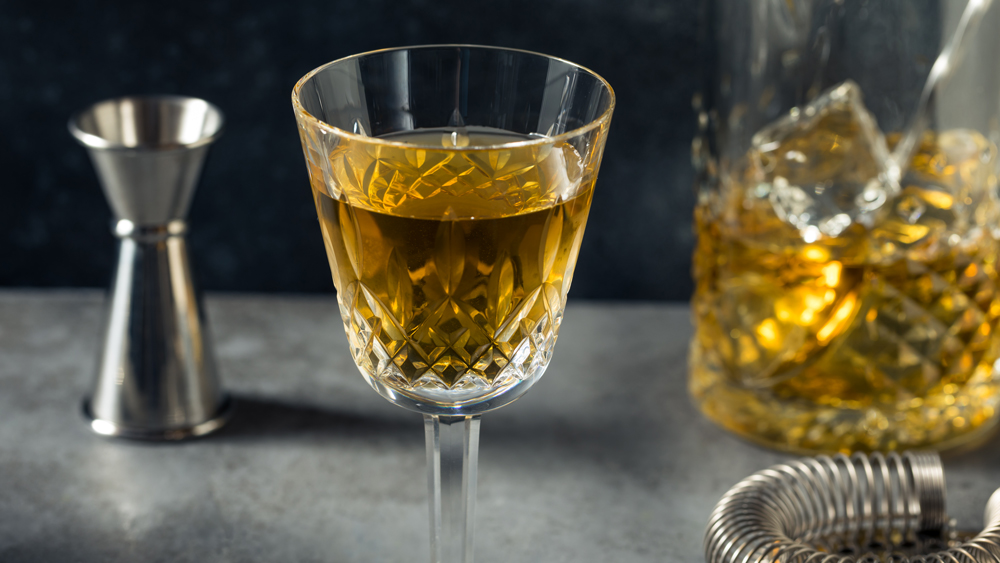What’s the worst letter you’ve ever received from an order of monks? I’ll go first. But before that, some context: The Bijou is a classic cocktail, created around 1900. To me, “Bijou” sounds like a cartoon bear, but it apparently means jewel in French, which is actually perfect for this drink.
The story you’ll hear again and again is that it’s named as such for the colors of its three main ingredients—sweet vermouth is red (rubies), Green Chartreuse is green (emerald) and gin is clear (diamonds)—which all sounds a little dumb to me, but who knows, it may have seemed less grandiose 120 years ago. No, the reason I think it’s perfect is that this cocktail feels like a gemstone. It’s both robust and strangely delicate, archaic and yet somehow timeless.
It’s multifaceted and beautiful. It’s a jewel. It’s the Green Chartreuse that gives the Bijou its beauty, its seductive complexity.
Gin and sweet vermouth go together extremely well, as we see in the Hanky Panky and the Don’t Give Up the Ship , but the Bijou is nothing so much as a Negroni but with Campari’s bright orange bitterness replaced with the herbal tsunami that is Green Chartreuse. It’s first published in the third edition of the New & Improved Bartender’s Manual by the hilariously named Harry Johnson, and the original specs, just like a Negroni, call for equal amounts of gin, vermouth and liqueur. Most modern recipes mess with this, however—Chartreuse is 55 percent alcohol to Campari’s 24 percent and is intense on a whole other order of magnitude, so almost everyone reduces the quantity of Chartreuse to let the other ingredients speak.
Even so, pretty much everyone thinks of the Bijou as a Green Chartreuse drink. So when the Carthusian monks—the order of silent French monks who make Chartreuse, coaxing dark herbal magic from 130 ingredients according to a secret recipe since like 1760—sent a letter to the world on January 16, informing us that they’re going to start making less of it, it was cause for some alarm. We love Chartreuse.
More than that, we need it. It’s strictly necessary for drinks like the Bijou and the Last Word. It’s also the best liqueur ever made.
It’s hard to get already and now it’s going to be harder? The monks say they’re decreasing production “to protect their monastic life and devote their time to solitude and prayer,” which I grudgingly admit, you can’t be too mad at. Monks are gonna monk, after all, and profit isn’t really their primary concern. But in this new world, where Chartreuse becomes rare and expensive, should we be making Bijous at all? I say yes.
Chartreuse is amazing on its own, but when folded into gin and sweet vermouth, we get to see what it’s capable of, offering a powerful herbal complexity that rumbles under the other two ingredients, like a brilliant bassist in a jazz trio. The gin brings piquant top notes and the vermouth adds bright fruit, but it’s the Chartreuse that gives it its soul, a gorgeous depth that evokes something slightly different every time you take a sip and reminding you that, like a jewel, some things are expensive because they’re valuable. Add all ingredients to a mixing glass with ice.
Stir for 10 to 15 seconds if using small ice, 20 to 25 seconds if using big ice, and garnish with a lemon peel. NOTES ON INGREDIENTS Brands in General: Even accounting for personal taste, I generally feel comfortable recommending one or two brands of a spirit or vermouth for a given cocktail. The problem with the Bijou, though, is that all three ingredients are botanical and complex, and interact with each other in unpredictable ways.
So while the below recommendations are my favorite from the handful of brands of gin and vermouth that I tried, each new combination will react in its own way, and will be worth exploring. Gin: Plymouth Gin is called for by name in the original recipe, but I thought Plymouth, at 41. 2 percent, was a little soft for this.
The Bijou sits on an edge, and you need to decide which way you’d like to lean. If “smoothness” (i. e.
, lack of alcohol heat) is more important to you, feel free to grab Plymouth or Sipsmith or any other gin in the lower-ABV range. If you’d prefer the gin to speak more clearly and don’t mind a little heat, my favorite was Tanqueray, which worked brilliantly. Sweet Vermouth: This I feel a bit more prescriptive about.
Chartreuse is big and needs a big flavor to stand up to it. I enjoyed the almost chocolate-like richness it coaxed out of the vanilla vermouths like Cocchi Vermouth di Torino. The plummy power of Carpano Antica can be good as well, but if you use Carpano make sure to use a big gin like Tanqueray or Beefeater, or else it’ll walk all over the gin.
Orange Bitters: Orange bitters are in every single recipe for this cocktail, but that said, I didn’t think they were always necessary. They were never bad, but sometimes I thought the cocktail was plenty good without them. My advice would be to make it, try it and add a single dash of orange bitters, and decide if you like that better.
As for brands, orange bitters are always a problem because there’s not any one brand that stands above the others, but in this case, if I could tell you to get anything it would be the bright & juicy Bittercube Orange Bitters. .
From: robbreport
URL: https://robbreport.com/food-drink/spirits/best-bijou-recipe-gin-chartreuse-vermouth-cocktail-1234814206/



